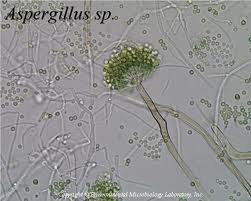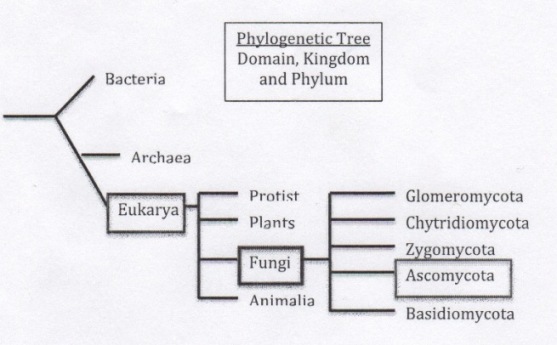Classification

Classification of Aspergillus flavus at a glance
Domain: Eukarya
Kingdom: Fungi
Phylum: Ascomycota
Class: Ascomycetes
Order: Eurotiales
Family: Trichocomaceae
Genus: Aspergillus
Species: Aspergillus flavus
The reason for this classification...

Domain: Eukarya
Aspergillus flavus is classified as Eukarya because it possesses a true nucleus and membrane bound organelles. This is the same taxonomic category as humans!
What do Aspergillus flavus and the King of Rock have in common? Answer: They are both Eukaryotes!
Members of the kingdom fungi are non-vascular (meaning they have no transport tissues), reproduce by means of spores, have cell walls composed of chitin, and are heterotrophic accomplishing this with exoenzymes. To learn more about other organisms classified in this kingdom visit Tom Volk's Fungi Website. To the right is Amanita muscaria, a mushroom within the Fungi Kingdom.
Phylum: Ascomycota
Phyla of fungi are distinguished based on their method of reproduction of sexual spores. Members of the Ascomycota produce their sexual spores (ascospores) internally in a sac called an ascus. They can also reproduce asexually in which case spores are borne externally as conidia. Here's the catch, A. flavus does NOT reproduce sexually! For this reason some classify the organism as being a part of the group deuteromycetes, or double classify it as being a part of both. However, molecular evidence places Aspergillus flavus in the phylum Ascomycota. Another organism found in this phylum is yeast!
Class: Ascomycetes
Members of this class are distinguished by presence of sexual spores within an ascus. Again, this organism does not reproduce by means of sexual spores but molecular data places it within this class.
Order: Eurotiales
Also known as the blue and green molds, the Eurotiales are recognized as having a closed ascocarp containing scattered asci rather than gathered.
Family: Trichocomaceae
Within this family of fungi, ascocarps form a cluster of threads which release ascospores after termination of asci. Another organism within this family that you may be familiar with is Penicillium chrysogenum the source of penicillin.

Genus: Aspergillus
Many species of this genus have symbiotic relationships with plants or animals. In addition they are most often found in environments that are aerobic. Aspergillus fumigatus (shown to the right) is also a pathogenic fungus within the genus.
Species: Aspergillus flavus
This species can be defined by its ability to produce aflatoxins. Another characteristic of this species is the color of the conidia which is yellow. This fungus only reproduces asexually.
Phylogeny

Here is a phylogenetic tree highlighting the domain, kingdom and phylum to which A. flavus belongs based upon molecular data. This tree was created by the author of this webpage, Alexa Ernst. *Keep in mind that "Protist" is no longer one kingdom, however for the sake of saving a little time and a lot of space I grouped them together.*

Here is a phylogenic tree of the other species within the genus of Aspergillus. This tree is based upon molecular data. As you can see, A. flavus is most closely related to Aspergillus oryzae. This is somewhat surprising because A. oryzae is used in Chinese and Japanese food to ferment soybeans, and in the making of alcoholic beverages such as huangjiu, sake, and shōchū. As I mentioned A. flavus is the producer of aflatoxin which is a harmful mycotoxin. This makes for an interesting family tree, it sounds like A. flavus is the evil stepsister.
To learn about where this species is found, check out the habitat page!




